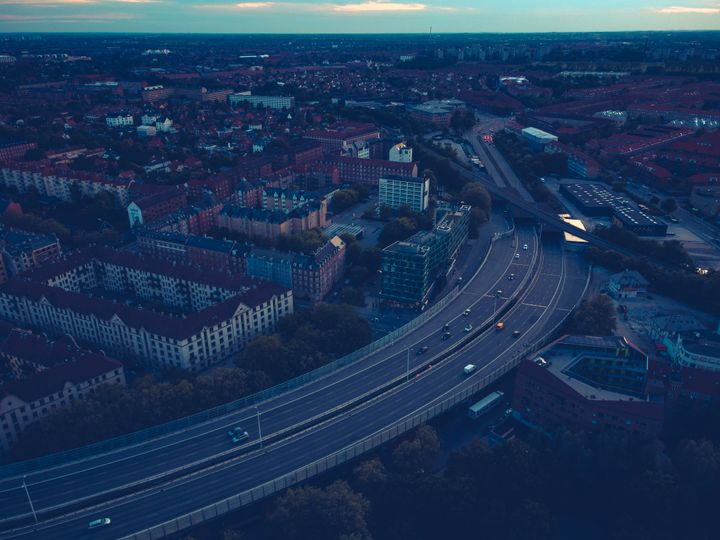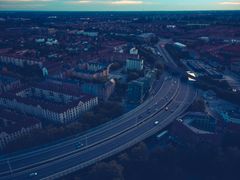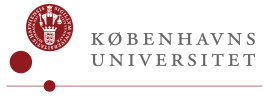Smog from Copenhagen’s Bispeengbuen heads straight into living rooms
A large amount of the heavy automobile pollution from Copenhagen’s Bispeengbuen thoroughfare goes straight into people's homes. This, according to a study by researchers at the University of Copenhagen. A sensor developed by one of the researchers can help fill in the blanks of our understanding about local air pollution.

Air pollution cuts the lives of more than four thousand Danes short every year. Locally, we have a very limited understanding how many harmful substances waft in the air we breath. Indeed, air pollution is only monitored at fourteen locations across Denmark.
This prompted University of Copenhagen chemists to set up their own measuring devices along one of the Danish capital’s busiest thoroughfares, a place where air quality is not otherwise measured: Namely by the Bispeengbuen – an elevated roadway that bisects densely populated residential areas and leads into and out of the heart of the Copenhagen. Pollution from the 50-70,000 cars that that drive over the six-lane raised road every day goes directly into nearby homes. Their results are presented in a study led by University of Copenhagen chemistry student Frederik Hildebrand which has just been published in the journal Dansk Kemi.
The scientists placed a range of low cost pollution sensors along Bispeengbuen, outside an inhabited apartment thirty-five meters from the roadway and inside one of the apartment's rooms. The devices, which were developed by researchers at the Department of Chemistry, measured air pollution levels for over four weeks.
"The sensor in the apartment was placed in a storage room where there were no people and where the doors and windows were closed for the entire period. Here, we found a close correlation between indoor and outdoor air pollution. This means that the air pollution originated outdoors and came into the room, despite it having been completely shut off. It was surprising," says Frederik Hildebrand.
Forty-eight percent of the pollution came from the roadway
The scientists’ measurements demonstrate that forty-eight percent of the apartment’s indoor air pollution comes directly from Bispeengbuen-generated car pollution.
"This could in part be due to it being an old building, which is not as well insulated as the newer ones. But for the most part, most of Copenhagen’s buildings are old. If one assumes that the same is true in other types of buildings that are similar, indoor pollution could be significant. Some of the homes are just five metres from the roadway," says Matthew S. Johnson, the Department of Chemistry professor who supervised the project and helped develop the sensor that was used.
The most alarming types of pollution the researchers measured were nitrogen dioxide (NO2) and fine particulate matter (PM2.5). NO2 is notorious for wreaking havoc on the lungs, causing cancer, dementia and cardiovascular diseases. Because they are so small, fine particles (PM2.5) can enter the lungs and find their way into the bloodstream and body. Among other things, the particles can lead to pulmonary diseases, diabetes, blood clots and cancer.
Exceeds WHO guidelines
While the average concentration of fine particles measured outdoors along the Bispeengbuen remained within the WHO guidelines for healthy air quality, the average level of NO2 exceeded the WHO's 24-hour limit values during the measurement period.
When PM2.5 concentrations were at their highest – which particularly occurred during the morning rush hour – they were more than ten times as high as the 24-hour limit values. For NO2, the values were six times as high.
"Our measurements at Bispeengbuen are as high as levels at the most polluted stretch of road in Denmark – H.C. Andersens Boulevard in downtown Copenhagen. The difference is that here we are up on the second floor, so the pollution is spread even more into the local area and most likely into people's homes," says Professor Johnson.
Within the apartment, concentrations remained below WHO limit values throughout the measurement period, during late spring of 2022:
"But that doesn't mean that it doesn't require attention. After all, the concentrations depend on the amount of traffic. In winter, we suspect that car traffic increases and alongside that, the amount of air pollution – as studies from elsewhere show. So, it is not impossible that the limits are exceeded," says Frederik Hildebrand.
"It is definitely worrying that there is such a close link between outdoor and indoor pollution. It finds its way in and is very likely to harm people's health. Part of the problem can be alleviated through building renovations. Still, it is very unfortunate planning for the roadway to be so close to the building," says Matthew S. Johnson.
After years of political discussion, it has been decided to demolish one of Bispeengbue two elevated roadways, which will be reduced from six lanes to three. What do the researchers think about this solution?
"Car traffic is still constant, so you really just move pollution from one place to another. If, on the other hand, you move traffic underground, you will not spread the pollution to the nearby areas, and you would be able to control it through filters and other things that can clean the air in the tunnel," says Frederik Hildebrand.
For the time being, measurements only gathered at three places in Copenhagen
Today, official air quality monitoring in Denmark is conducted with instruments that provide very precise measurements, but are large, expensive and energy intensive. Therefore, the number of measuring stations is severely limited, with only 14 stations spread across Denmark. Three of them are in Copenhagen.
"So, you need a more accurate picture of the rest of Copenhagen and of local effects in general. This is what the sensors we’ve deployed here can provide – faster, better and cheaper. For example, we have set up 225 of these measuring devices around the Borough of Camden in London. They serve as a good complement to official measurement networks. Working side-by-side these networks can provide us with much better knowledge than we have today about how polluted the air we breathe really is," concludes Professor Johnson.
*
FACT BOX: AIR POLLUTION FATALITIES
- Danish calculations show that air pollution in Denmark in 2020 resulted in 4,030 premature deaths. 3,170 of the deaths are due to sources of air pollution abroad, while 860 cases are due to Danish sources. Danish sources also contribute approximately 1,930 premature deaths annually in Europe. (Source: Air pollution - Danish Health Authority)
- According to a 2019 estimate, 11.65% of all deaths worldwide are due to air pollution. This makes air pollution the third leading cause of death after smoking and high blood pressure.
- In 2019, outdoor air pollution was estimated to cause 4.2 million premature deaths worldwide. (source: WHO)
FACT BOX: RESEARCHERS PRODUCE THE SENSORS THEMSELVES
- The measuring devices used by the researchers in the study are low-cost sensors developed by the Danish company DevLabs. The company was founded by Matthew S. Johnson and other chemists from the same University of Copenhagen research group.
- The low-cost sensors are compact, have low energy consumption and cost 100 to 1,000 times less than traditional air pollution monitoring devices. This makes it possible to create affordable networks of devices for studying local pollution at a previously unheard of level. However, the sensors must be calibrated against a more accurate and more expensive measuring instrument.
FACT BOX: ABOUT THE STUDY
- The research article of the study has been published in the journal Dansk Kemi.
- The authors are Frederik B. Hildebrand, Jens-Christian N. Poulsen and Matthew S. Johnson from the Department of Chemistry and Louise B. Frederickson from DevLabs/Aarhus University.
Keywords
Contacts
Frederik Hildebrand
BSc. Chemistry
University of Copenhagen
hwp980@alumni.ku.dk
+45 29 25 89 54
Matthew S. Johnson
Professor
Department of Chemistry
University of Copenhagen
msj@chem.ku.dk
+45 35 32 03 00
Maria Hornbek
Journalist
Faculty of Science
University of Copenhagen
maho@science.ku.dk
+45 22 95 42 83
Images

Links
ABOUT THE FACULTY OF SCIENCE
The Faculty of Science at the University of Copenhagen – or SCIENCE – is Denmark's largest science research and education institution.
The Faculty's most important task is to contribute to solving the major challenges facing the rapidly changing world with increased pressure on, among other things, natural resources and significant climate change, both nationally and globally.
Subscribe to releases from Københavns Universitet - Det Natur- og Biovidenskabelige Fakultet
Subscribe to all the latest releases from Københavns Universitet - Det Natur- og Biovidenskabelige Fakultet by registering your e-mail address below. You can unsubscribe at any time.
Latest releases from Københavns Universitet - Det Natur- og Biovidenskabelige Fakultet
Old aerial photos give scientists a new tool to predict sea level rise3.7.2025 08:00:00 CEST | Press release
Researchers from the University of Copenhagen have gained unique insight into the mechanisms behind the collapse of Antarctic ice shelves, which are crucial for sea level rise in the Northern Hemisphere. The discovery of old aerial photos has provided an unparalleled dataset that can improve predictions of sea level rise and how we should prioritise coastal protection and other forms of climate adaptation.
Gamle luftfotos giver forskere nyt redskab til at forudsige havstigninger3.7.2025 08:00:00 CEST | Pressemeddelelse
Forskere fra Københavns Universitet har fået unik adgang til at forstå mekanismerne bag antarktiske ishylders kollaps, som er afgørende for havstigninger på den nordlige halvkugle. Et fund af gamle luftfotos har skabt et enestående datasæt, som kan forbedre vores forudsigelser af hvor meget havene stiger, og vores prioritering af kystsikring og andre klimatilpasninger.
Ny institutleder på IFRO: ”Faglighed og fællesskab går hånd i hånd”1.7.2025 10:49:17 CEST | Pressemeddelelse
Per Svejstrup er fra 1. august ansat som institutleder på Institut for Fødevare- og Ressourceøkonomi (IFRO). Den kommende leder træder ind i rollen med stor respekt for IFRO's faglige og kollegiale kultur med klare ambitioner for fremtiden.
Dangerous Variant of Salmonella Still Not Eradicated – Researchers Point to the Solutions1.7.2025 09:53:23 CEST | Press release
The infectious and multi-resistant cattle disease Salmonella Dublin can be fatal to both humans and animals and causes significant losses for farmers. Although Denmark has attempted to eradicate the disease since 2008, it has not yet succeeded. A study from the University of Copenhagen points to possible reasons – and the necessary solutions.
Farlig type salmonella er stadig ikke nedkæmpet i Danmark – forskere peger på løsningerne30.6.2025 09:54:03 CEST | Pressemeddelelse
Den smitsomme og multiresistente kvægsygdom Salmonella Dublin kan være dødelig for både mennesker og dyr og medfører desuden betydelige tab for landmændene. Selvom Danmark har forsøgt at udrydde sygdommen siden 2008, er det ikke lykkedes. Et studie fra Københavns Universitet peger på den mulige årsag og de nødvendige løsninger.
In our pressroom you can read all our latest releases, find our press contacts, images, documents and other relevant information about us.
Visit our pressroom